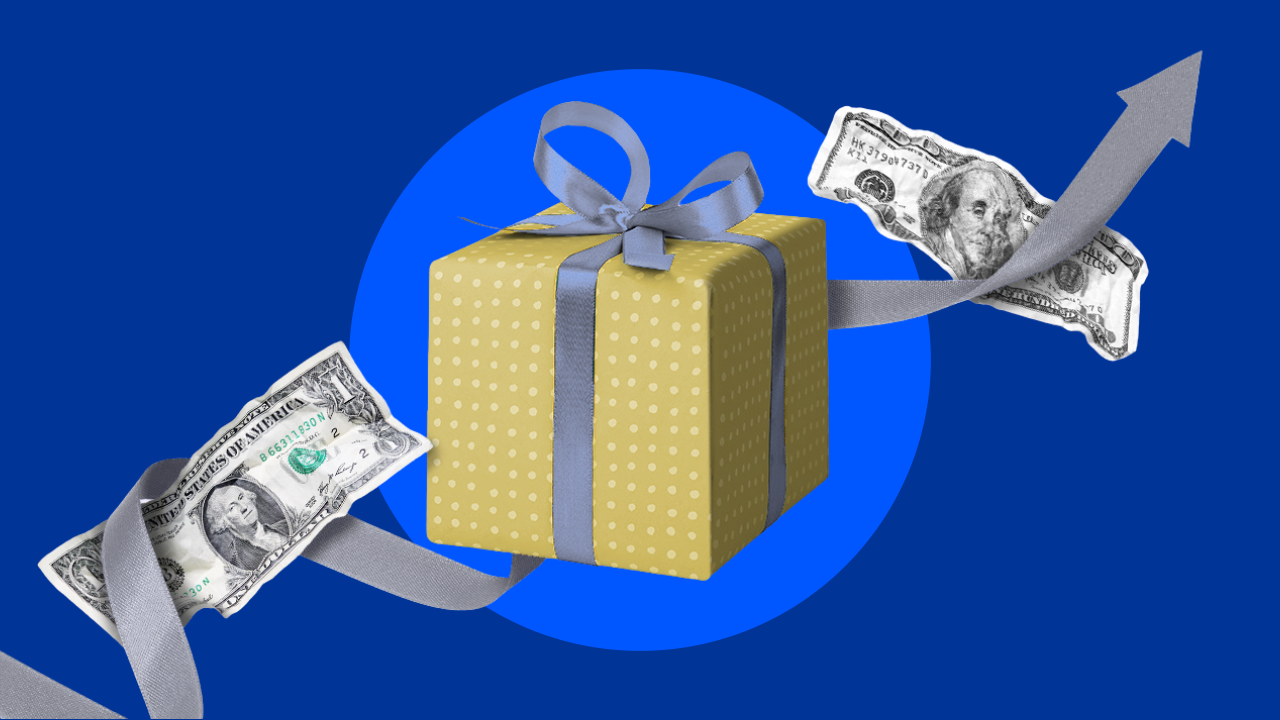After two years of cheaper deals and better prices, holiday shoppers may have to reach deeper into their wallets again this season, as inflation makes an unwelcome return to many of the items households buy this time of year.
More than 3 in 4 holiday staples (78%) have gotten more expensive since September 2024, according to Bankrate’s annual analysis of 50 common holiday staples in the Bureau of Labor Statistics’ consumer price index (CPI). That’s the highest share since 2022, when 88% of the goods Bankrate tracks rose in price.
A little bit of inflation is normal in a growing economy. The Federal Reserve aims for an annual “not-too-hot, not-too-cold” rate of about 2%. And while prices overall aren’t climbing as fast as they were during 2022’s peak, the trend is moving in the wrong direction. This year, prices on 76% of holiday items rose at a faster pace than the year before, compared with just 30% in 2024.
These renewed price pressures come at a time when many Americans are feeling financially squeezed. The economy is growing at a healthy pace, but not everyone is reaping the same rewards. Wealthier households have benefited from a strong stock market, while many middle- and lower-income families are still struggling to keep up with the high price of everyday life. Wages haven’t fully caught up to total post-pandemic inflation, and a slowing job market has made finding new work the hardest since the Great Recession.
Signs of strain are already showing. Just 21% of adults plan to fly or stay in a hotel or short-term rental this holiday season, down from 27% who planned to travel in 2024, according to Bankrate’s Holiday Spending Report. Lower-income households were among those who planned to cut back the most. Similarly, 2 in 5 holiday shoppers (41%) said they were worried about gifts costing more this year, Bankrate’s Early Holiday Shopping Survey found.
But Americans are still expected to spend, fueling the consumption that powers economic growth. Retail sales in November and December are projected to rise another 3.7%-4.2% from a year ago, according to estimates from the National Retail Federation. Some households, though, may make tough financial choices to do it: 28% of holiday shoppers say they may take on debt to afford their purchases, Bankrate also found in September.
There is a K-shaped economy, and higher earners are propping up these stats. But if there’s one time a year that people splurge, it’s the holidays. If we do see a pullback in spending, it’ll be more next year.
— Ted Rossman, Bankrate industry analyst
Gifts and holiday entertaining are getting more expensive this year, as food inflation and tariffs start to bite
Bankrate separated 50 holiday essentials into four categories: gifts, experiences, travel and entertaining.
Hosting a holiday party or cooking for family and friends may hit Americans’ wallets the hardest this year. Six of the 10 most inflated holiday items fall into the “entertaining” category, which covers seasonal staples like poultry, turkey, fish, sugar and sweets, as well as household paper products, alcoholic beverages and soft drinks.
Prices in this category rose much faster than they did a year ago. More than half of “entertaining” items (56%) increased faster than the Fed’s 2% target, compared with just 17% last year.
The patterns reflect broader inflation trends, with food prices heating up again. Grocery costs — measured by the Bureau of Labor Statistics’ “food at home” index — have risen by 2% or more each month since March, after holding below the Fed’s target for 16 straight months.
The “gifts” category, meanwhile, saw the biggest shift from last year. In 2024, prices for many gifts were falling. Nearly two-thirds of gift items (65%) got cheaper thanks to flashy sales and discounts from big-box retailers. About a third (35%) grew in price. This year, that trend flipped. Only one in four gifts (25%) are cheaper than they were a year ago, while three in four (75%) have gotten more expensive.
The shift highlights a change in the overall drivers of inflation. Up until earlier this year, “goods” prices were cooling — and in some cases, even falling — as supply chains improved. This slowdown helped cool overall inflation.
That relief, however, has now faded. In September 2025, commodity prices accounted for nearly a quarter (24%) of overall inflation, the most since 2022. Put a different way, if goods costs had held steady in the latest CPI report, the overall inflation rate would have been closer to 2.3% instead of 3%, Bankrate calculations show.
Roughly the same number of items in the “travel” and “experiences” category increased and decreased this year as they did last year. Still, the majority of the items within those categories (80% and 86%, respectively) rose by a faster pace in 2025 than they did in 2024.
Airline tickets are up 3.2% from a year ago, for example, while transportation services have increased 2.7%.
These are the 10 items getting most expensive this year
| Item | 2025 | 2024 | 2023 | 2022 | 2021 |
| Candy | 9.8% | 0.4% | 7.6% | 13.1% | 2.0% |
| Meats | 8.4% | 2.5% | 2.9% | 4.6% | 12.4% |
| Sugar and sweets | 6.7% | 0.9% | 6.5% | 14.4% | 2.8% |
| Watches | 6.6% | 6.4% | -2.6% | 2.2% | 2.6% |
| Energy services | 6.5% | 3.4% | -3.4% | 19.9% | 8.6% |
| Musical instruments and accessories | 6.1% | -1.0% | 7.9% | 4.0% | 2.5% |
| Household paper products | 5.5% | -1.1% | 6.5% | 12.4% | 5.3% |
| Nonalcoholic beverages and beverage materials | 5.3% | 1.3% | 4.1% | 12.9% | 3.7% |
| Postage and delivery | 4.8% | 5.4% | 4.8% | 4.4% | 3.3% |
| Tools, hardware, outdoor equipment and supplies | 4.3% | -4.5% | 6.3% | 12.5% | 3.2% |
These experts say tariffs are a major factor driving up prices
Overall, holiday inflation is not as punishing as it was a few years ago. Back in 2022, the average item in the holiday entertaining category, for example, rose 14.3%. This year, the average item jumped 3.3%.
Even so, rising goods prices are catching Fed Chair Jerome Powell’s attention. Chair Powell said last month that they’re a key reason inflation has climbed every month since April, — and he pointed to tariffs as the culprit.
“You’ve seen goods prices increasing, and that’s really due to tariffs,” he said at the Fed’s post-meeting press conference in October. “In contrast, disinflation appears to be continuing for services.”
That connection is showing up in the data. Musical instruments, for example, have a 15.3% effective tariff rate, according to Mastercard’s 2025 Holiday SpendingPulse report. That was the sixth most inflated item in Bankrate’s analysis, rising 6.1% from a year ago, after decreasing 1% the year before.
Mastercard’s Chief Economist Michelle Meyer estimates that the overall holiday inflation costs are up about 1.7%, as of her latest data from July. A year ago, the typical basket of holiday goods was 2.3% cheaper.
“It’s a different environment today than it was at this time last year,” she says. “Today, incrementally, prices are rising, and inflation is accelerating. It is not an abrupt shock to the system, but on the margin, it’s slightly higher prices, and that’s what consumers are trying to manage this holiday shopping season.”
Inflation hasn’t surged as much as some economists feared after President Donald Trump imposed sweeping tariffs last April during his “Liberation Day” announcement. Clothing, for instance, carries an effective 25.4% tariff rate, according to Meyer’s analysis, yet prices over the past 12 months edged slightly lower, Bankrate’s analysis found.
New trade deals with major partners like the European Union, China, Japan and Vietnam have helped ease some costs. Trump also recently lowered tariffs on certain food imports, including beef, tomatoes, bananas and coffee. Still, the average effective tariff rate on all U.S. imports remains higher than at any point since the Great Depression, according to a Yale Budget Lab analysis.
Mark Matthews, chief economist at the National Retail Federation, estimates businesses have passed along more than a quarter of tariff-related costs to consumers. Many firms stockpiled inventory to avoid higher duties, he said. Some have even tried adjusting prices across categories to avoid shocking consumers — raising costs on some items with steadier demand to keep others more affordable. In other words, just because an item has a higher tariff rate doesn’t mean businesses are able to pass along those higher prices to their customers.
“Retailers are going to do their best to continue to absorb costs on some of those items,” Matthews says. “That might mean those costs get passed off into some other parts of their portfolio.”
But they can’t keep holding the line forever, he adds.
“The one clear message that I hear back from retailers is that this absorption of costs by U.S. businesses is something that can’t continue,” Matthews says.
Here’s where to find the deals this holiday season
Only 11 of the 50 holiday essentials Bankrate tracks are cheaper than they were a year ago — roughly half as many as last year, when 21 items fell in price.
Even with higher inflation, the “gifts” category is still the place where consumers are most likely to find the best deals: Apparel, computers, recreational books, televisions and smartphones all cost less in September 2025 than they did a year earlier.
Some travel-related costs are also lower. Gasoline prices, hotel rooms and car rentals have all dipped, offering some relief for holiday travelers.
A look at the 11 items that fell from last year
| Item | 2025 | 2024 | 2023 | 2022 | 2021 |
| Apparel | -0.01% | 1.8% | 2.2% | 5.4% | 3.4% |
| Gasoline (all types) | -0.5% | -15.2% | 3.1% | 18.4% | 42.0% |
| Computers, peripherals and smart home assistance devices | -0.7% | -4.7% | -5.2% | -3.6% | 8.5% |
| Hotels and motels | -0.8% | -3.5% | 8.2% | 3.3% | 20.0% |
| Eggs | -1.3% | 39.5% | -14.6% | 30.3% | 12.5% |
| Recreational books | -1.7% | 1.3% | 0.1% | 1.5% | 0.9% |
| Photographers and photographic services (unadjusted) | -2.3% | -4.8% | 6.6% | 6.4% | 0.3% |
| Car and truck rental | -5.0% | -6.8% | -8.7% | -1.3% | 43.1% |
| Televisions | -6.0% | -5.4% | -10.2% | -17.8% | 12.7% |
| Admission to sporting events | -6.9% | 10.3% | 18.9% | -9.5% | *Not collected |
| Smartphones (unadjusted) | -14.9% | -9.3% | -15.4% | -21.0% | -19.6% |
Retailers are still expected to offer promotions to compete with other businesses. Unlike last year, though, consumers are likely to snag the best deals earlier in the season, Meyer says.
About half of holiday shoppers planned to begin their holiday shopping before the end of October, Bankrate’s 2025 Early Holiday Shopping Survey found.
“Last year, [consumers] knew it was an overwhelmingly well-priced environment. They saw the discounts throughout the year. It was well understood that prices would be even lower the longer you waited to purchase. I don’t think that’s the view this time around,” Meyer says. “If people shop early and aggressively, we could face slightly less inventory at the end of the year, which means you won’t have the same degree of discounting.”
Retailers, meanwhile, are facing their own financial pressures. Higher costs are squeezing profit margins, making it harder to offer as steep of markdowns as last year, even as firms try to appeal to budget-conscious shoppers, Matthews said.
“The consumer more than ever is trying to stretch their dollars, so they are going to be on the look out for deals,” Matthews says. “But you have to counter that with the fact that retailers are margin pressured. It’s going to be harder to offer deep discounts.”
5 ways to tariff-proof your spending — and not break the bank — this holiday season
The ultimate question is whether consumers can handle higher prices this holiday season. More expensive plane tickets or food costs might force consumers to pull back in other areas.
“For certain products, consumers may accept higher prices. For others, they are trying to fight it,” Meyer says. “Lower-income, budget-constrained households will change what’s in their basket of spend.”
Across all incomes, households have more funds in their checking accounts than in 2019, according to the Bank of America Institute’s recent ConsumerPulse study. Those figures tell David Tinsley, a senior economist at the Institute, that households are still in “decent” financial shape heading into the height of the holiday shopping season. Spending per household on holiday items — items where over 20% of annual spending takes place in November or December — is up 5.7% from a year ago through October, Bank of America’s data shows.
Volumes, though, are down, meaning consumers are spending more to buy less. Among higher-income households meanwhile, spending is up 2.7% in October from a year ago, versus just 0.7% for lower-income households, Bank of America data shows.
“There’s a lot of fragility under the surface,” he says. “At the bottom and middle, you’ll feel like it’s more of a stretch this year than the last few years, while the top will be in a stronger position.”
1. Start shopping and budgeting as early as possible, so you can monitor prices
Before starting your holiday shopping, it’s wise to know how much you can afford to spend. Take a look at your finances and figure out what your “hard stop” holiday number is — that is, the number you realistically can’t afford to go over. Putting purchases beyond your limit on a credit card will only leave you in a worse position once the holiday season is over.
If you haven’t already built up a holiday savings fund, consider eliminating some discretionary purchases to free up cash over the next few months.
The sooner you start shopping, the better, experts say. Set up price alerts, compare prices at multiple retailers and try to time your purchase with when you think you’ll find the best deal. Tools like CamelCamelCamel or Honey can help you research an item’s price history to ensure your discount is indeed a good deal.
“If you see something and you think it’s a good price, you better snap it up,” Matthews says. “It just may not be there later in the season.”
2. Make sure retailers have your information, so you can receive targeted offers
Matthews points to an emerging trend in the retail industry that could help out consumers this shopping season: targeted discounts. If a retailer sees that you’ve been browsing a specific item, they might be more likely to offer you an exclusive coupon or a deal. Consider downloading a store’s app, signing up for an account or giving them some type of contact information.
“Make sure retailers have visibility of you to increase your odds of making sure you’re exposed to deals,” Matthews said. “In the past, you could sit back and just wait for these big deals to happen. It might take a little bit more involvement on the consumers’ part to make sure they’re staying on top of what’s happening.”
3. Look for more unique ways to give gifts
Americans hoping to limit the impact high prices have on their holiday budgets may want to embrace the unconventional.
Planning to travel for the holidays? Consider skipping or cutting back on decorations for your home if you’re going to be somewhere else anyway. Still want to throw a holiday party? Host a potluck so no one person has to take on the cost burden.
Americans might also be able to split gifts with others or give groups of people a gift they can share, such as purchasing a gift card for a family to enjoy a meal out together. Other options could be creating your own gift for loved ones, which might be even more meaningful than something that’s purchased.
4. Don’t forget about unused points or miles
When creating your holiday budget, don’t forget to check whether you have any unused miles or credit card rewards you can redeem for gifts or travel costs. Consumers are often sitting on a stockpile of credit card rewards — “free” money that can only be put to use if it is, in fact, used.
Even unused gift cards could fund some of your holiday budget — or be the gift itself. More than 2 in 5 adults (43%) have at least one unused gift card, gift voucher or store credit, according to Bankrate polling from September.
The right travel credit card could also be your saving grace in a high-inflationary environment. Not only do they offer savings on flights, but many of these cards cover checked bags or travel insurance that can also help you save on any additional costs that arise due to delays or cancellations.
5. Best honest with loved ones about your budget
Talking about money can be uncomfortable. Americans feel less comfortable discussing financial topics such as their bank account balances, salaries and credit card debt than other potentially sensitive issues, such as politics, religion and their weight, according to Bankrate’s Financial Taboos Survey.
But if you’re struggling, there’s no shame in having a conversation with the people in your life so you can celebrate the holidays in a way everyone enjoys. In the long run, it might even be healthier for your finances and your relationships. Remember: Your loved ones don’t want to see you in credit card debt, either.
“Other people may be feeling the same way, so you might get some heads nodding when you say, ‘Money is a little tight. Can we cut back a bit?’” Rossman says. “Your presence is the present. Prioritize your time, especially if you’re spending money to travel and be there with everybody.”
Why we ask for feedback
Your feedback helps us improve our content and services. It takes less than a minute to
complete.
Your responses are anonymous and will only be used for improving our website.
Help us improve our content
Read the full article here

















